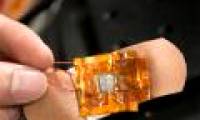
For a long time, touch has always played an important role in developing robots as well as improving the quality of fake limbs used for people with disabilities.

A battery sensitive to temperature, thus preventing the risk of fire and equipment, newly invented in the United States.

Stanford University scientists built the first solar cell made entirely of carbon, promising to replace the expensive materials used in photovoltaic devices today.

A research team from Stanford University has developed into a battery park that uses sodium at a much cheaper cost than lithium-ion batteries.

Recently, Stanford University researchers have successfully developed an electronic device that functions as a human skin and in addition to the ability to change colors like a

American physicists have created a super-soft material capable of healing scratches, cuts and the ability to feel contact. This material can be used to make artificial leather.

Scientists at Stanford University (USA) have developed a successful one
 For a long time, touch has always played an important role in developing robots as well as improving the quality of fake limbs used for people with disabilities.
For a long time, touch has always played an important role in developing robots as well as improving the quality of fake limbs used for people with disabilities. A battery sensitive to temperature, thus preventing the risk of fire and equipment, newly invented in the United States.
A battery sensitive to temperature, thus preventing the risk of fire and equipment, newly invented in the United States. Stanford University scientists built the first solar cell made entirely of carbon, promising to replace the expensive materials used in photovoltaic devices today.
Stanford University scientists built the first solar cell made entirely of carbon, promising to replace the expensive materials used in photovoltaic devices today. A research team from Stanford University has developed into a battery park that uses sodium at a much cheaper cost than lithium-ion batteries.
A research team from Stanford University has developed into a battery park that uses sodium at a much cheaper cost than lithium-ion batteries. Recently, Stanford University researchers have successfully developed an electronic device that functions as a human skin and in addition to the ability to change colors like a
Recently, Stanford University researchers have successfully developed an electronic device that functions as a human skin and in addition to the ability to change colors like a American physicists have created a super-soft material capable of healing scratches, cuts and the ability to feel contact. This material can be used to make artificial leather.
American physicists have created a super-soft material capable of healing scratches, cuts and the ability to feel contact. This material can be used to make artificial leather. Scientists at Stanford University (USA) have developed a successful one
Scientists at Stanford University (USA) have developed a successful one






 The Mystery of Biology: Why Can't We Build Airplanes With Wings Like Dragonflies?
The Mystery of Biology: Why Can't We Build Airplanes With Wings Like Dragonflies? Top 10 geniuses with the greatest inventions in history
Top 10 geniuses with the greatest inventions in history The phenomenon of 'moving borders' changes the shape of countries
The phenomenon of 'moving borders' changes the shape of countries Decoding the naming of streets in Hanoi: Surprising truths not everyone knows!
Decoding the naming of streets in Hanoi: Surprising truths not everyone knows! The Mystery and Engineering Feat of Albano Emissary: The 2,000-Year-Old Roman Tunnel
The Mystery and Engineering Feat of Albano Emissary: The 2,000-Year-Old Roman Tunnel Great ways to relieve stress and beat boredom
Great ways to relieve stress and beat boredom The snow-white mountain stands tall in the middle of the green plain: Unexpectedly, it is a giant garbage dump!
The snow-white mountain stands tall in the middle of the green plain: Unexpectedly, it is a giant garbage dump! Giant pyramid 'appears' in the middle of the highway in Mexico
Giant pyramid 'appears' in the middle of the highway in Mexico